Water Quality Variation Law and Prediction Method of a Small Reservoir in China
Abstract
:1. Introduction
2. Study Methods
2.1. Study Area
2.2. Data Analysis
2.3. Machine Learning Model–Eureqa
2.4. Data Prediction
- (1)
- Enter training and validation data.
- (2)
- The random equation generator generates preliminary equations that combine operational factors (such as constants and variables) with operations (addition, subtraction, multiplication, division, etc.).
- (3)
- MAE was used to compare the predicted values generated by the equations with the measured values of the test group. Bad solutions are discarded. The rest of the program hybridizes with the probability function given by the program and generates a new sub-expression according to the inherent mutation probability function.
- (4)
- Stop the program when a reasonable solution appears (it will not stop automatically). This program will provide a series of solutions with different accuracy and complexity.
3. Results
3.1. Vary Law of the Parameters in Yangmeiling Reservoir
3.2. The Analysis of the Optimal Result
4. Discussion
5. Conclusions
- (1)
- The analysis shows that runoff and the nitrogen and phosphorus content in the runoff have a very significant relationship with rainfall, and the formula related to rainfall can be used to predict runoff and nitrogen and phosphorus concentration.
- (2)
- It is found that the nitrogen and phosphorus content of the Inside reservoir is less than the nitrogen and phosphorus concentration in the runoff and can also be obtained by using the relevant formula with rainfall, runoff and pollutant concentration content in the runoff. The simple formula is more conducive to the promotion and application of the model and does not provide a theoretical basis for the water quality management of small reservoirs.
Author Contributions
Funding
Institutional Review Board Statement
Informed Consent Statement
Data Availability Statement
Conflicts of Interest
References
- Zhang, S.; Zeng, Y.; Zha, W.; Huo, S.; Niu, L.; Zhang, X. Spatiotemporal variation of phosphorus in the Three Gorges Reservoir: Impact of upstream cascade reservoirs. Environ. Sci. Pollut. Res. 2022, 29, 56739–56749. [Google Scholar] [CrossRef] [PubMed]
- Winston, B.; Scott, J.T.; Pollock, E. The synergistic effect of elevated CO2 and phosphorus on reservoir eutrophication. Lake Reserv. Manag. 2016, 32, 373–385. [Google Scholar] [CrossRef]
- Lima, D.J.N.; Menezes, R.F.; Araújo, F.O. Phosphorus fractions and their availability in the sediments of eight tropical semiarid reservoirs. J. Soils Sediments 2022, 22, 982–993. [Google Scholar] [CrossRef]
- Lu, T.; Chen, N.; Duan, S.; Chen, Z.; Huang, B. Hydrological controls on cascade reservoirs regulating phosphorus retention and downriver fluxes. Environ. Sci. Pollut. Res. 2016, 23, 24166–24177. [Google Scholar] [CrossRef]
- Khare, Y.; Naja, G.M.; Stainback, G.A.; Martinez, C.J.; Paudel, R.; van Lent, T. A Phased Assessment of Restoration Alternatives to Achieve Phosphorus Water Quality Targets for Lake Okeechobee, Florida, USA. Water 2019, 11, 327. [Google Scholar] [CrossRef] [Green Version]
- Bai, Y.; Gao, J.; Zhang, Y. Research on wind-induced nutrient release in Yangshapao Reservoir, China. Water Supply 2020, 20, 469–477. [Google Scholar] [CrossRef]
- Xu, Z.; Yu, C.; Sun, H.; Yang, Z. The response of sediment phosphorus retention and release to reservoir operations: Numerical simulation and surrogate model development. J. Clean. Prod. 2020, 271, 122688. [Google Scholar] [CrossRef]
- Dang, C.; Lu, M.; Mu, Z.; Li, Y.; Chen, C.; Zhao, F.; Cheng, Y. Phosphorus fractions in the sediments of Yuecheng Reservoir, China. Water 2019, 11, 2646. [Google Scholar] [CrossRef] [Green Version]
- Huang, L.; Fang, H.; He, G.; Jiang, H.; Wang, C. Effects of internal loading on phosphorus distribution in the Taihu Lake driven by wind waves and lake currents. Environ. Pollut. 2016, 219, 760–773. [Google Scholar] [CrossRef]
- Shi, W.; Zhu, L.; Van Dam, B.; Smyth, A.R.; Deng, J.; Zhou, J.; Pan, G.; Yi, Q.; Yu, J.; Qin, B. Wind induced algal migration manipulates sediment denitrification N-loss patterns in shallow Taihu Lake, China. Water Res. 2022, 209, 117887. [Google Scholar] [CrossRef]
- Hu, Y.; Peng, Z.; Zhang, Y.; Liu, G.; Zhang, H.; Hu, W. Air temperature effects on nitrogen and phosphorus concentration in Lake Chaohu and adjacent inflowing rivers. Aquat. Sci. 2022, 84, 33. [Google Scholar] [CrossRef]
- Gibbons, K.J.; Bridgeman, T.B. Effect of temperature on phosphorus flux from anoxic western Lake Erie sediments. Water Res. 2020, 182, 116022. [Google Scholar] [CrossRef] [PubMed]
- Bai, Y.; Zeng, Y.; Nie, B.; Jiang, H.; Zhang, X. Hydrodynamic disturbance on phosphorus release across the sediment–water interface in Xuanwu Lake, China. Water Supply 2019, 19, 735–742. [Google Scholar] [CrossRef]
- Wells, S.A.; Berger, C.J. Modeling the response of dissolved oxygen to phosphorus loading in Lake Spokane. Lake Reserv. Manag. 2016, 32, 270–279. [Google Scholar] [CrossRef]
- Katsev, S. When large lakes respond fast: A parsimonious model for phosphorus dynamics. J. Great Lakes Res. 2017, 43, 199–204. [Google Scholar] [CrossRef]
- Yang, X.; Ji, G.; Wang, C.; Zuo, J.; Yang, H.; Xu, J.; Chen, R. Modeling nitrogen and phosphorus export with InVEST model in Bosten Lake basin of Northwest China. PLoS ONE 2019, 14, e0220299. [Google Scholar] [CrossRef] [PubMed]
- Du, C.; Li, Y.; Lyu, H.; Liu, N.; Zheng, Z.; Li, Y. Remote estimation of total phosphorus concentration in the Taihu Lake using a semi-analytical model. Int. J. Remote Sens. 2020, 41, 7993–8013. [Google Scholar] [CrossRef]
- Han, H.J.; Los, F.J.; Burger, D.F.; Lu, X.X. A modelling approach to determine systematic nitrogen transformations in a tropical reservoir. Ecol. Eng. 2016, 94, 37–49. [Google Scholar] [CrossRef]
- Yosri, A.; Siam, A.; El-Dakhakhni, W.; Dickson-Anderson, S. A Genetic Programming–Based Model for Colloid Retention in Fractures. Groundwater 2019, 57, 693–703. [Google Scholar] [CrossRef]
- Bai, Y.; Yang, J.; Sun, G.; Zhao, Y.; Yu, Y. A genetic programming-based model for predicting phosphorus concentration in shallow lakes. Water Pract. Technol. 2022, 17, 637–644. [Google Scholar] [CrossRef]
- Sriworamas, K.; Kangrang, A.; Thongwan, T.; Prasanchum, H. Optimal Reservoir of Small Reservoirs by Optimization Techniques on Reservoir Simulation Model. Adv. Civ. Eng. 2021, 2021, 6625743. [Google Scholar] [CrossRef]
- Chao, J.Y.; Zhang, Y.M.; Kong, M.; Zhuang, W.; Wang, L.; Shao, K.; Gao, G. Long-term moderate wind induced sediment resuspension meeting phosphorus demand of phytoplankton in the large shallow eutrophic Lake Taihu. PLoS ONE 2017, 12, e0173477. [Google Scholar] [CrossRef] [PubMed] [Green Version]
- Zhu, G.; Qin, B.; Gao, G. Direct evidence of phosphorus outbreak release from sediment to overlying water in a large shallow lake caused by strong wind wave disturbance. Chin. Sci. Bull. 2005, 50, 577–582. [Google Scholar] [CrossRef]
- Shinohara, R.; Imai, A.; Kohzu, A.; Tomioka, N.; Furusato, E.; Satou, T.; Sano, T.; Komatsu, K.; Miura, S.; Shimotori, K. Dynamics of particulate phosphorus in a shallow eutrophic lake. Sci. Total Environ. 2016, 563, 413–423. [Google Scholar] [CrossRef] [PubMed]
- Tammeorg, O.; Niemistö, J.; Möls, T.; Laugaste, R.; Panksep, K.; Kangur, K. Wind-induced sediment resuspension as a potential factor sustaining eutrophication in large and shallow Lake Peipsi. Aquat. Sci. 2013, 75, 559–570. [Google Scholar] [CrossRef]
- Maceina, M.J.; Soballe, D.M. Wind-related limnological variation in Lake Okeechobee, Florida. Lake Reserv. Manag. 1990, 6, 93–100. [Google Scholar] [CrossRef]
- Kamiya, H.; Ohshiro, H.; Tabayashi, Y.; Kano, Y.; Mishima, K.; Godo, T.; Yamamuro, M.; Mitamura, O.; Ishitobi, Y. Phosphorus release and sedimentation in three contiguous shallow brackish lakes, as estimated from changes in phosphorus stock and loading from catchment. Landsc. Ecol. Eng. 2011, 7, 53–64. [Google Scholar] [CrossRef]
- Spears, B.M.; Carvalho, L.; Paterson, D.M. Phosphorus partitioning in a shallow lake: Implications for water quality management. Water Environ. J. 2007, 21, 47–53. [Google Scholar] [CrossRef]
- Søndergaard, M.; Jensen, J.P.; Jeppesen, E. Role of sediment and internal loading of phosphorus in shallow lakes. Hydrobiologia 2003, 506, 135–145. [Google Scholar] [CrossRef]
- Selig, U.; Hübener, T.; Michalik, M. Dissolved and particulate phosphorus forms in a eutrophic shallow lake. Aquat. Sci. 2002, 64, 97–105. [Google Scholar] [CrossRef]
- Koza, J.R. Human-competitive results produced by genetic programming. Genet. Program. Evolvable Mach. 2010, 11, 251–284. [Google Scholar] [CrossRef] [Green Version]
- Schmidt, M.; Lipson, H. Eureqa (Version 0.995 Beta); Nutonian: Somerville, MA, USA, 2003. [Google Scholar]
- Koza, J.R. Genetic programming as a means for programming computers by natural selection. Stat. Comput. 1994, 4, 87–112. [Google Scholar] [CrossRef]
- Tinoco, R.O.; Goldstein, E.B.; Coco, G. A data-driven approach to develop physically sound predictors: Application to depth-averaged velocities on flows through submerged arrays of rigid cylinders. Water Resour. Res. 2015, 51, 1247–1263. [Google Scholar] [CrossRef]
- Liu, M.Y.; Huai, W.X.; Yang, Z.H.; Zeng, Y.H. A genetic programming-based model for drag coefficient of emergent vegetation in open channel flows. Adv. Water Resour. 2020, 140, 103582. [Google Scholar] [CrossRef]
- Peel, M.C.; McMahon, T.A. Historical development of rainfall-runoff modeling. Wiley Interdiscip. Rev. Water 2020, 7, e1471. [Google Scholar] [CrossRef]
- Tao, Z.; Li, M.; Si, B.; Pratt, D. Rainfall intensity affects runoff responses in a semi-arid catchment. Hydrol. Process. 2021, 35, e14100. [Google Scholar] [CrossRef]
- Gao, J.; Bai, Y.; Cui, H.; Zhang, Y. The effect of different crops and slopes on runoff and soil erosion. Water Pract. Technol. 2020, 15, 773–780. [Google Scholar] [CrossRef]
- Bai, Y.; Cui, H. An improved vegetation cover and management factor for RUSLE model in prediction of soil erosion. Environ. Sci. Pollut. Res. 2021, 28, 21132–21144. [Google Scholar] [CrossRef] [PubMed]
- Liu, J.; Gao, G.; Wang, S.; Jiao, L.; Wu, X.; Fu, B. The effects of vegetation on runoff and soil loss: Multidimensional structure analysis and scale characteristics. J. Geogr. Sci. 2018, 28, 59–78. [Google Scholar] [CrossRef] [Green Version]
- López-Vicente, M.; Calvo-Seas, E.; Álvarez, S.; Cerdà, A. Effectiveness of Cover Crops to Reduce Loss of Soil Organic Matter in a Rainfed Vineyard. Land 2020, 9, 230. [Google Scholar] [CrossRef]
- Barrena-González, J.; Rodrigo-Comino, J.; Gyasi-Agyei, Y.; Pulido, M.; Cerdá, A. Applying the RUSLE and ISUM in the Tierra de Barros Vineyards (Extremadura, Spain) to Estimate Soil Mobilisation Rates. Land 2020, 9, 93. [Google Scholar] [CrossRef] [Green Version]
- Keesstra, S.D.; Rodrigo-Comino, J.; Novara, A.; Giménez-Morera, A.; Pulido, M.; Di Prima, S.; Cerdà, A. Straw mulch as a sustainable solution to decrease runoff and erosion in glyphosate-treated clementine plantations in Eastern Spain. An assessment using rainfall simulation experiments. Catena 2019, 174, 95–103. [Google Scholar] [CrossRef]
- Moradi, E.; Rodrigo-Comino, J.; Terol, E.; Mora-Navarro, G.; Marco da Silva, A.; Daliakopoulos, I.N.; Cerdà, A. Quantifying Soil Compaction in Persimmon Orchards Using ISUM (Improved Stock Unearthing Method) and Core Sampling Methods. Agriculture 2020, 10, 266. [Google Scholar] [CrossRef]
- Jiang, C.; Zhang, H.; Zhang, Z.; Wang, D. Model-based assessment soil loss by wind and water erosion in China’s Loess Plateau: Dynamic change, conservation effectiveness, and strategies for sustainable restoration. Glob. Planet. Change 2019, 172, 396–413. [Google Scholar] [CrossRef]
- Bhagowati, B.; Ahamad, K.U. A review on lake eutrophication dynamics and recent developments in lake modeling. Ecohydrol. Hydrobiol. 2019, 19, 155–166. [Google Scholar] [CrossRef]
- Zhang, Q.; Jin, J.; Zhu, L.; Lu, S. Modelling of water surface temperature of three lakes on the Tibetan Plateau using a physically based lake model. Atmos. Ocean 2018, 56, 289–295. [Google Scholar] [CrossRef]
- Guo, M.; Zhuang, Q.; Yao, H.; Golub, M.; Leung, L.R.; Pierson, D.; Tan, Z. Validation and Sensitivity Analysis of a 1-D Lake Model Across Global Lakes. J. Geophys. Res. Atmos. 2021, 126, e2020JD033417. [Google Scholar] [CrossRef]
- Hunt, B.G.; Dix, M.R. Stochastic implications for long-range rainfall predictions. Clim. Dyn. 2017, 49, 4189–4200. [Google Scholar] [CrossRef]
- Jain, S.; Scaife, A.A.; Mitra, A.K. Skill of Indian summer monsoon rainfall prediction in multiple seasonal prediction systems. Clim. Dyn. 2019, 52, 5291–5301. [Google Scholar] [CrossRef]
- Xiao, D.; Li Liu, D.; Feng, P.; Wang, B.; Waters, C.; Shen, Y.; Tang, J. Future climate change impacts on grain yield and groundwater use under different cropping systems in the North China Plain. Agric. Water Manag. 2021, 246, 106685. [Google Scholar] [CrossRef]
- O’Neill, B.C.; Tebaldi, C.; van Vuuren, D.P.; Eyring, V.; Friedlingstein, P.; Hurtt, G.; Sanderson, B.M. The scenario model intercomparison project (ScenarioMIP) for CMIP6. Geosci. Model Dev. 2016, 9, 3461–3482. [Google Scholar] [CrossRef] [Green Version]
- Perga, M.E.; Maberly, S.C.; Jenny, J.P.; Alric, B.; Pignol, C.; Naffrechoux, E. A century of human-driven changes in the carbon dioxide concentration of lakes. Glob. Biogeochem. Cycles 2016, 30, 93–104. [Google Scholar] [CrossRef] [Green Version]
- Schindler, D.W. Recent advances in the understanding and management of eutrophication. Limnol. Oceanogr. 2006, 51, 356–363. [Google Scholar] [CrossRef] [Green Version]
- Garrido, M.; Cecchi, P.; Malet, N.; Bec, B.; Torre, F.; Pasqualini, V. Evaluation of FluoroProbe® performance for the phytoplankton-based assessment of the ecological status of Mediterranean coastal lagoons. Environ. Monit. Assess. 2019, 191, 204. [Google Scholar] [CrossRef]

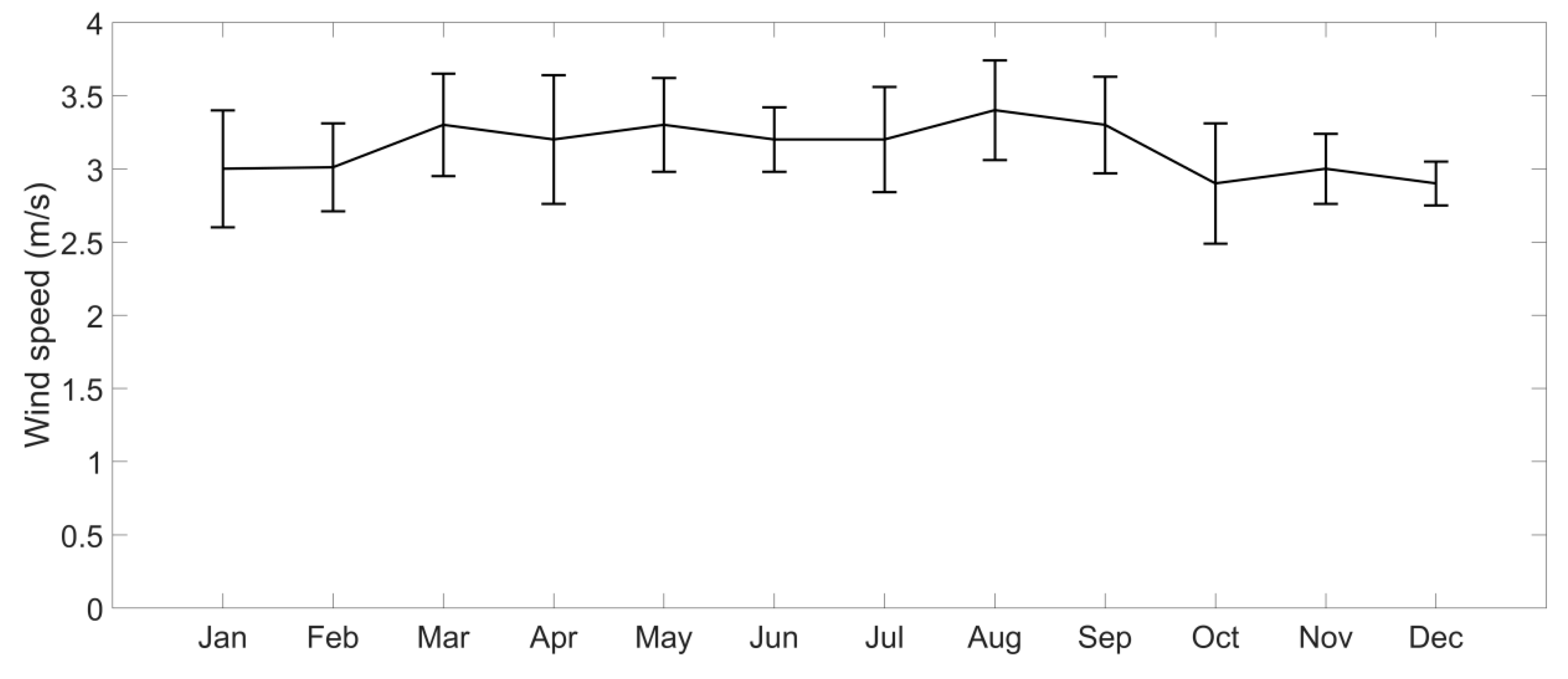
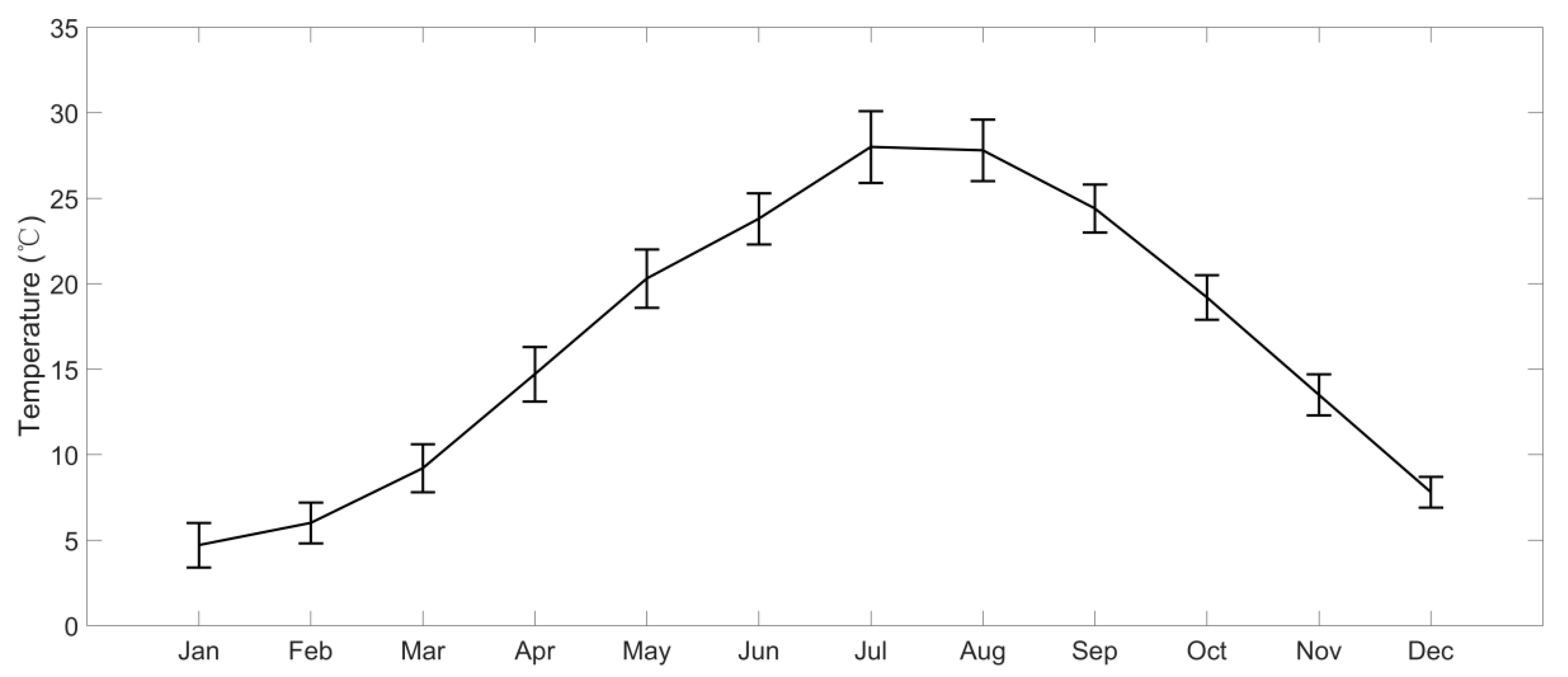
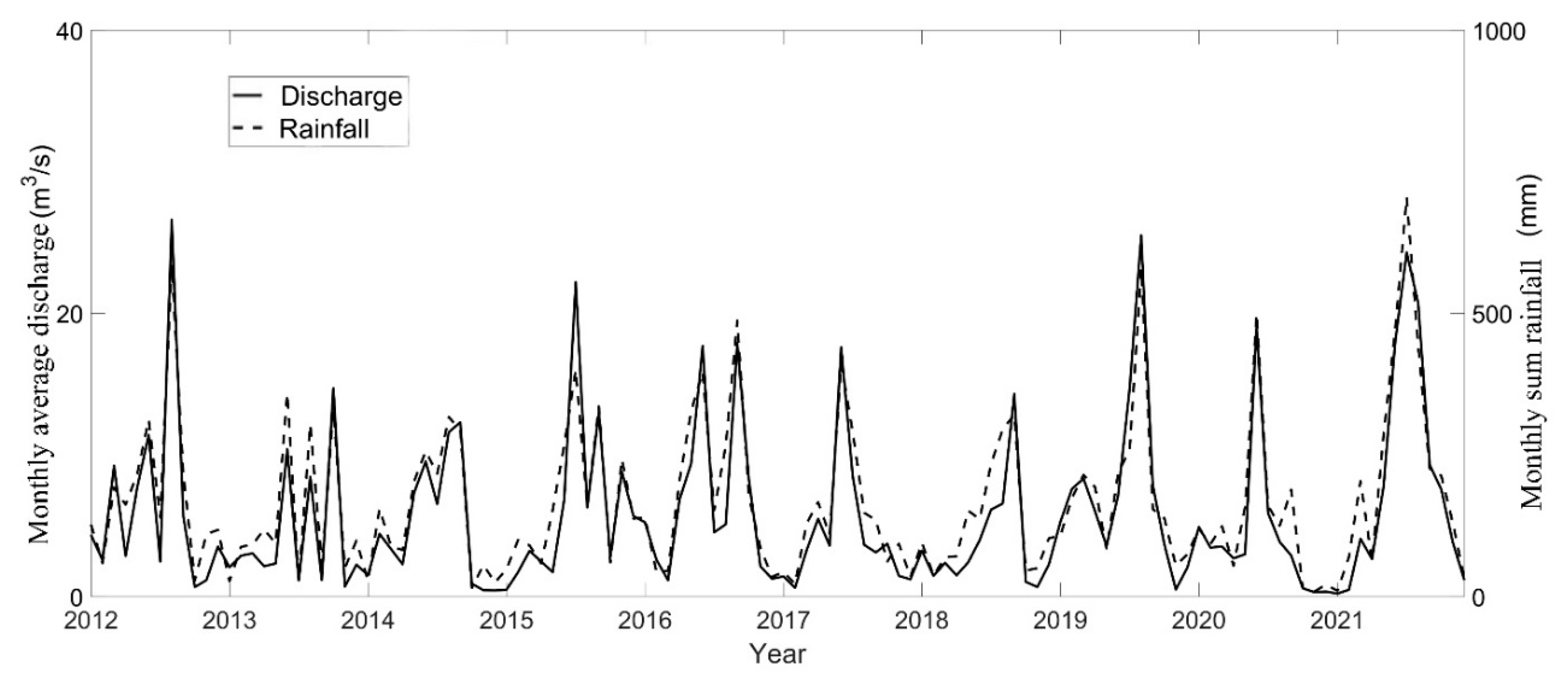
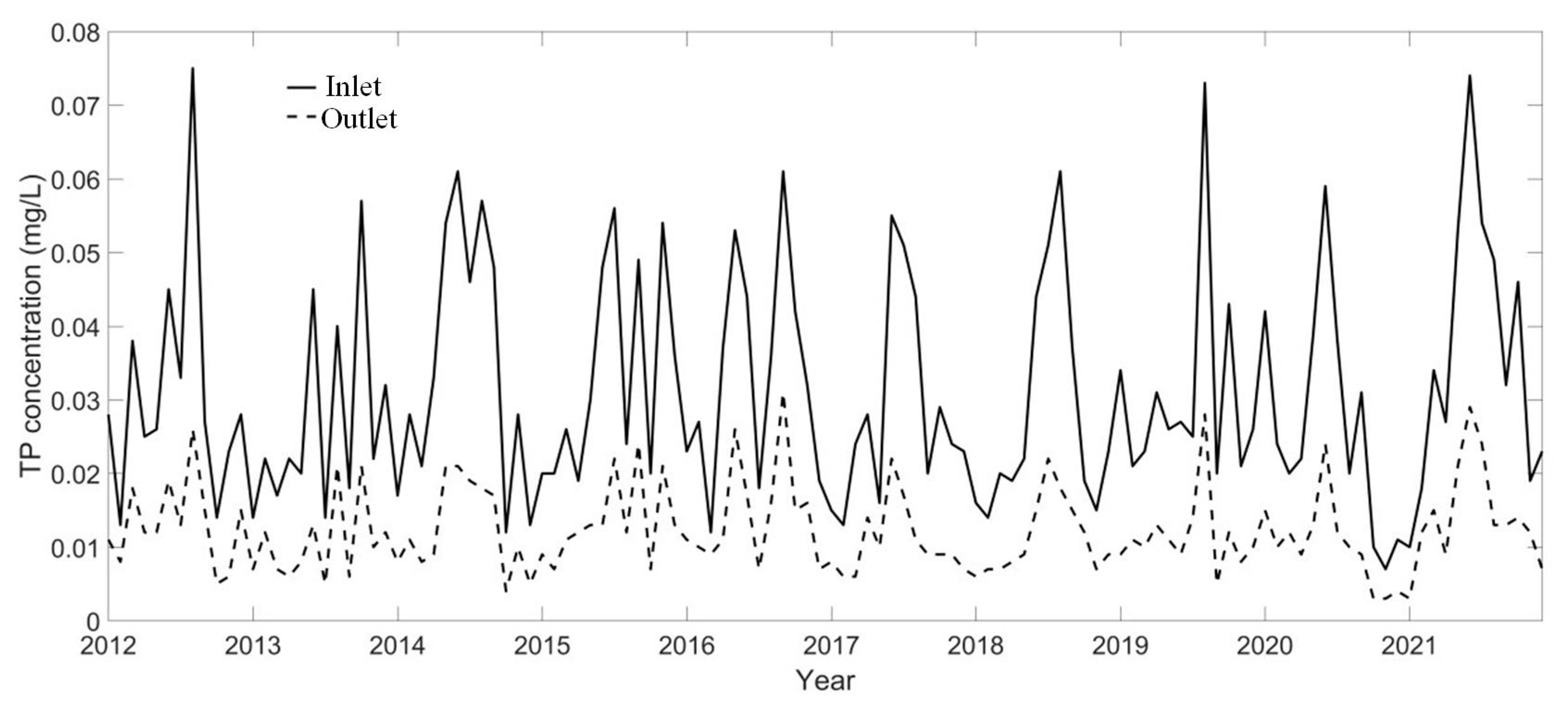
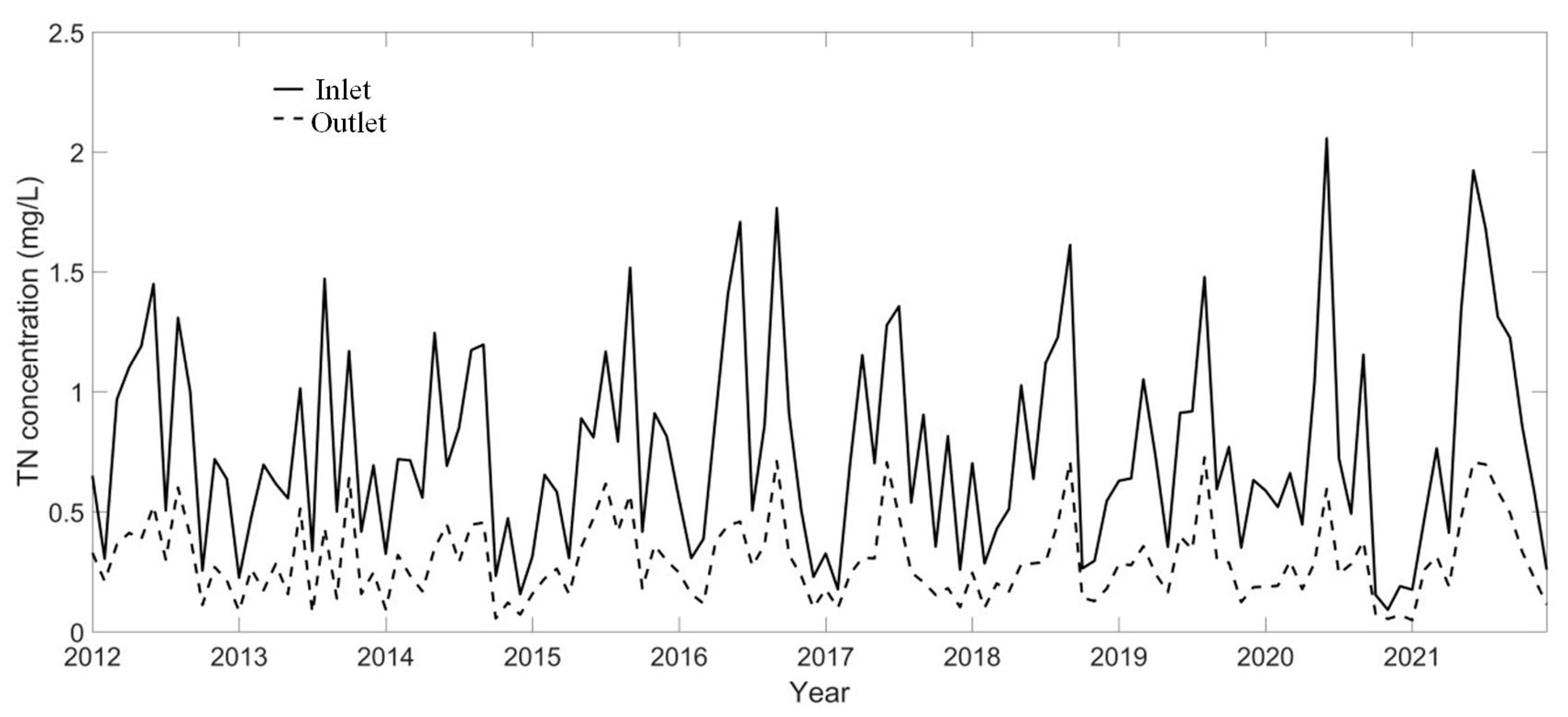
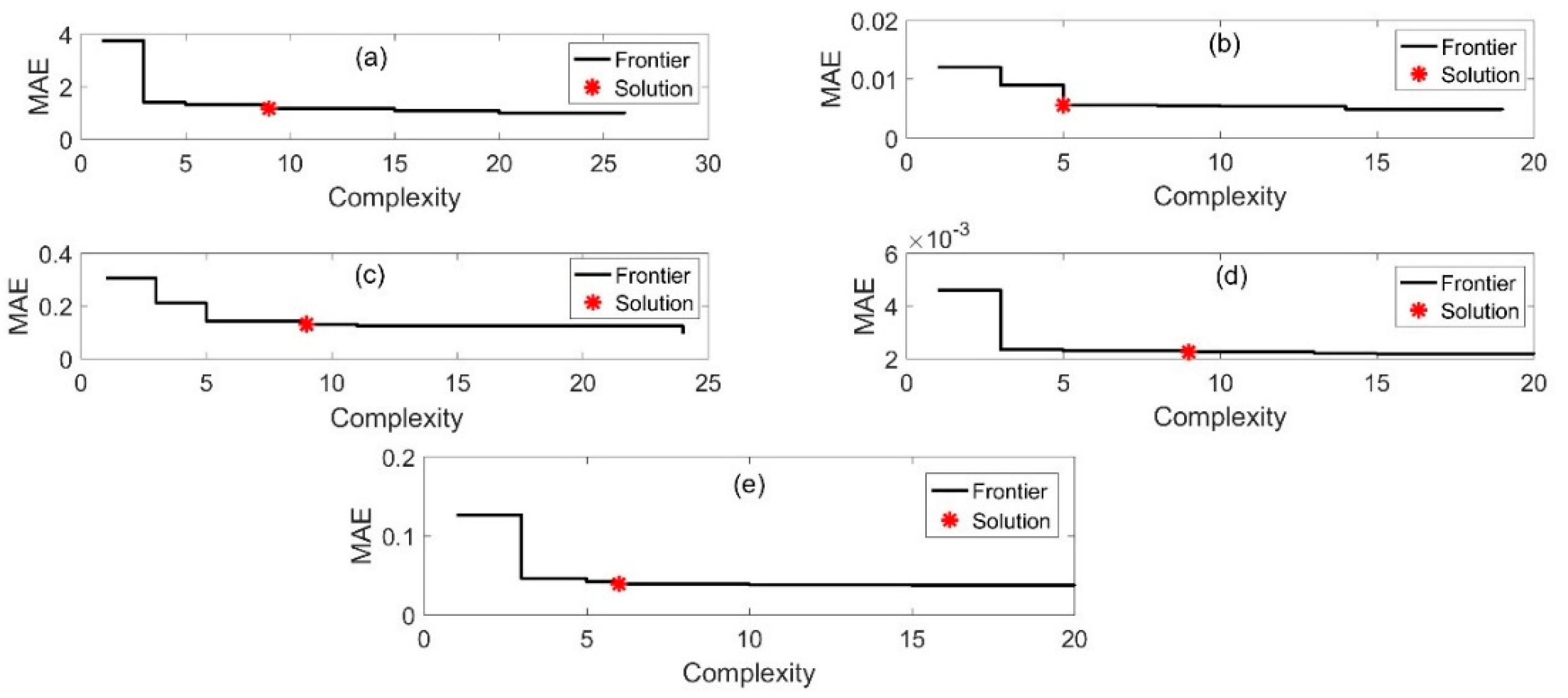
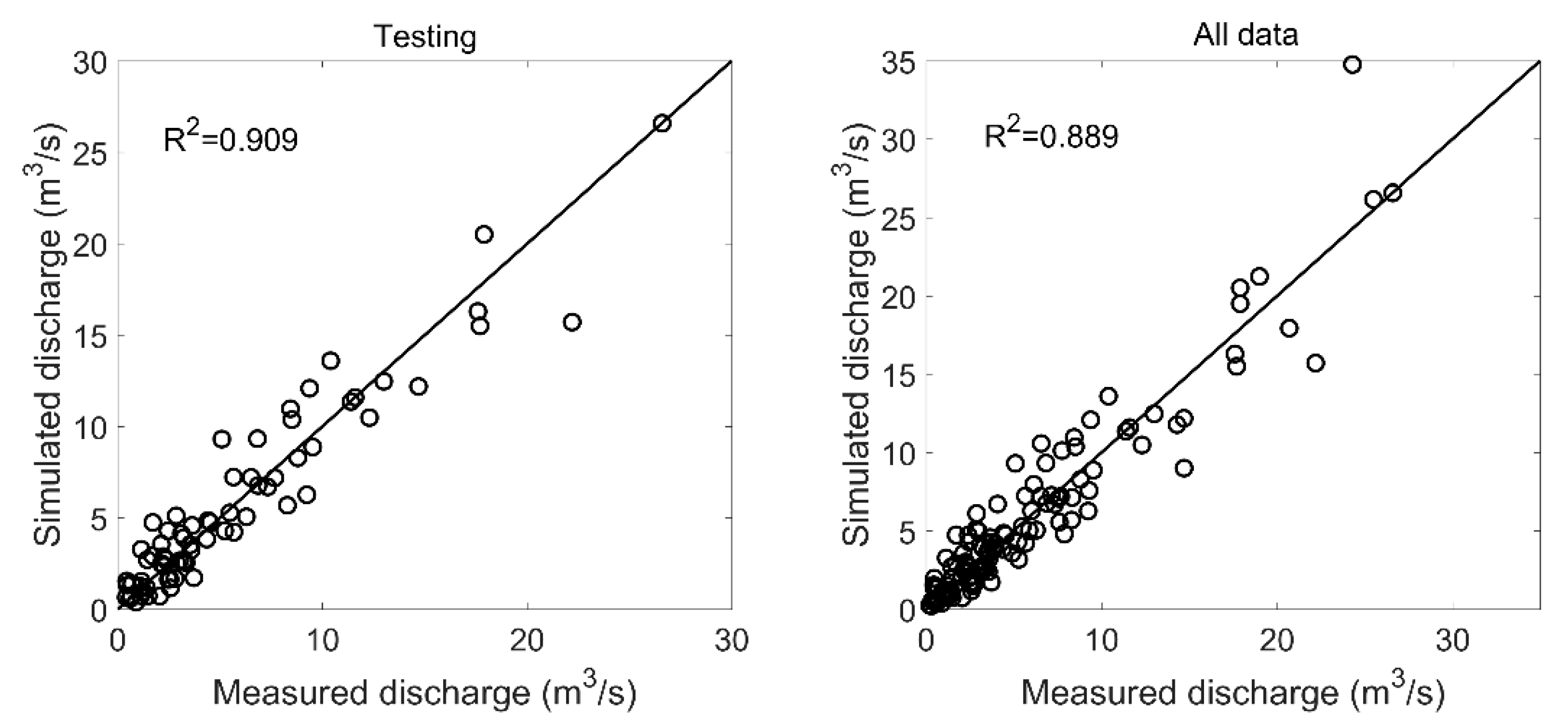
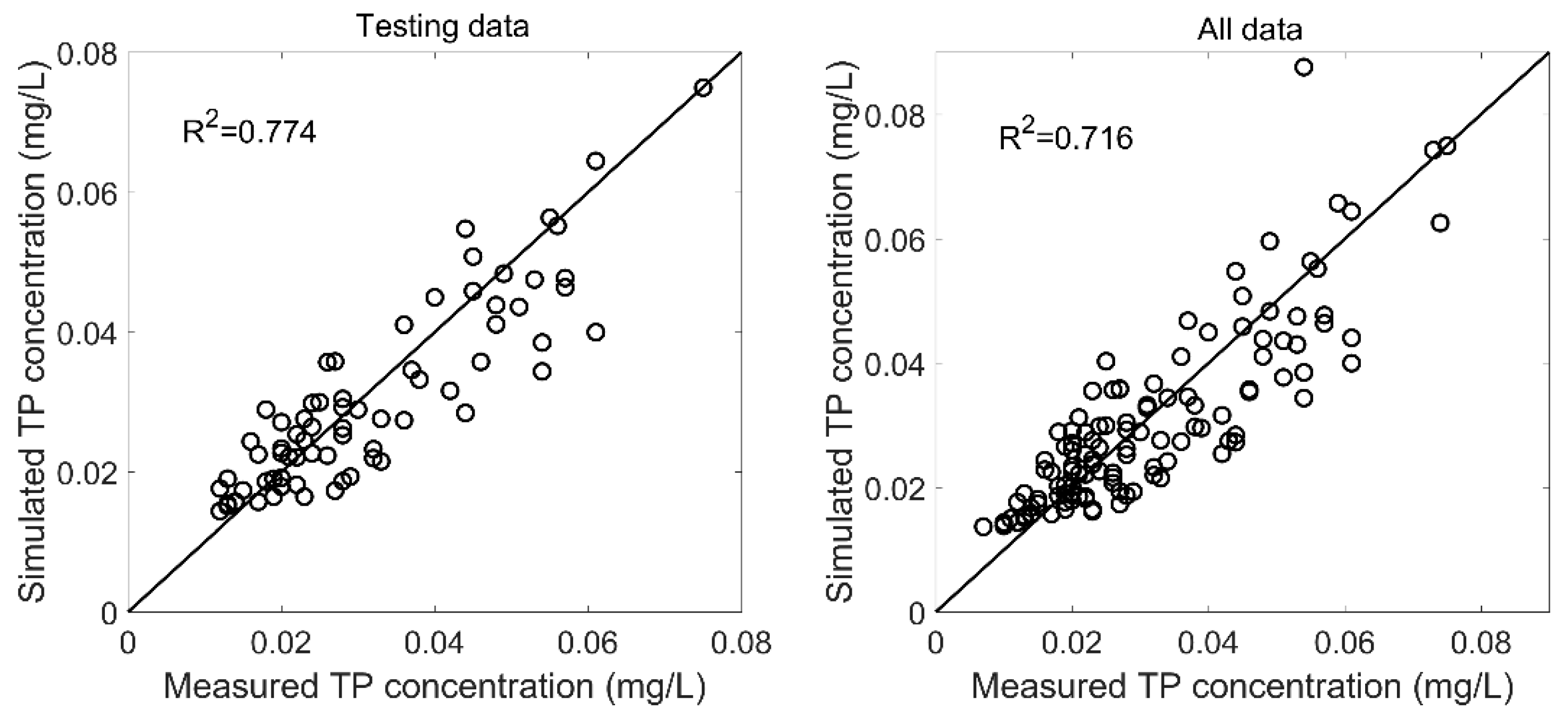
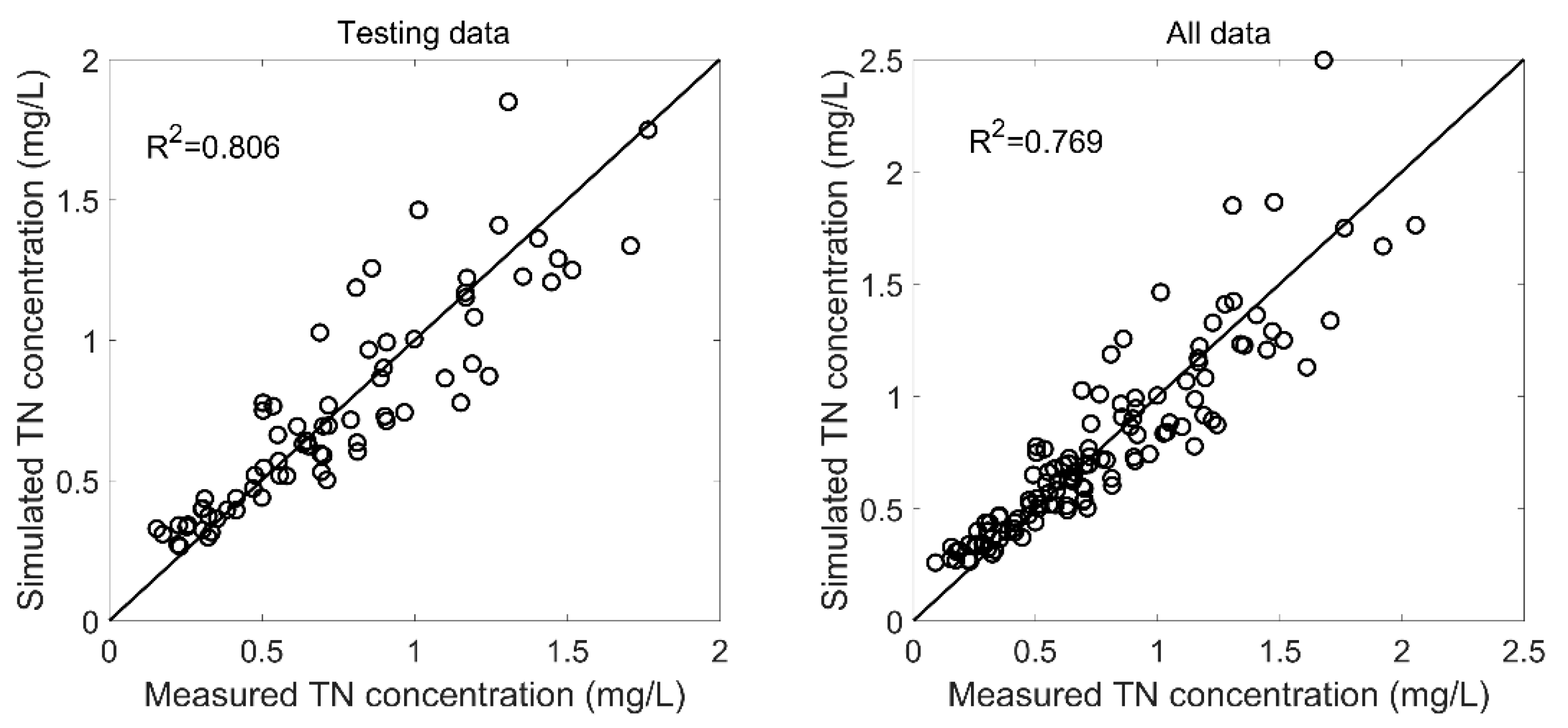
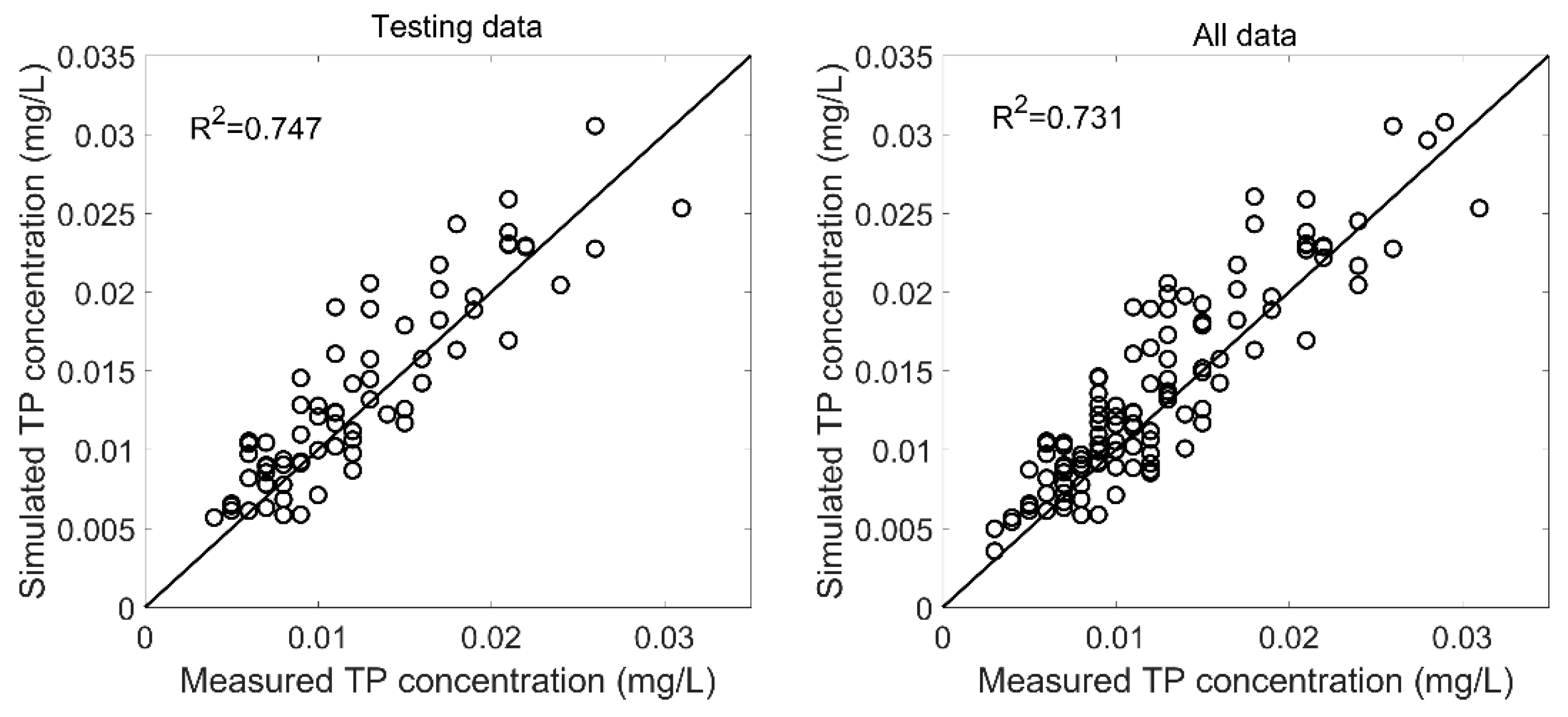
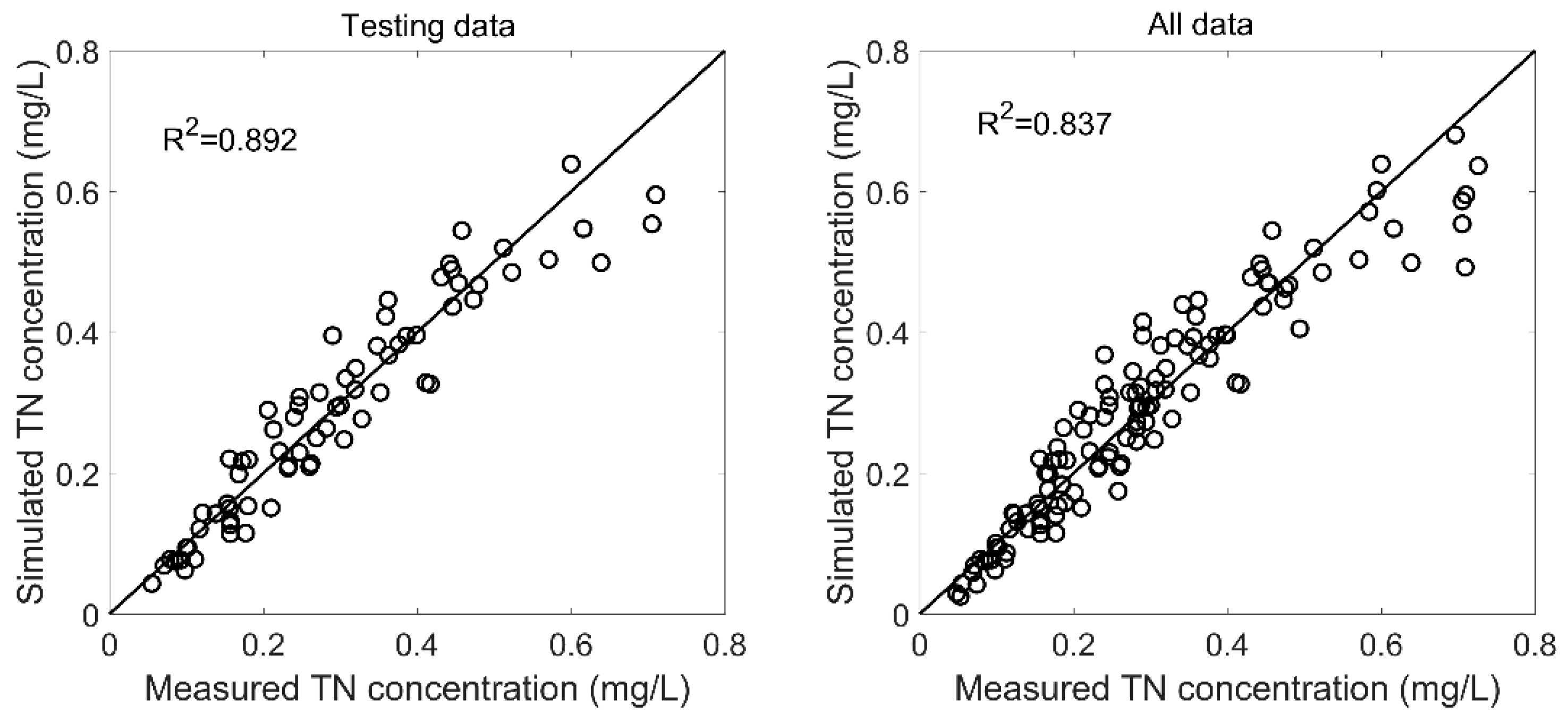
| 1 | 0.7867 b | 0.901 a,b | 0.8191 b | 0.7958 b | 0.8514 a,b | 0.23 | 0.5512 | 0.3747 | |
| 1 | 0.8113 b | 0.903 a,b | 0.8065 b | 0.8928 a,b | 0.2598 | 0.5605 | 0.532 | ||
| 1 | 0.8209 b | 0.7889 b | 0.8463 b | 0.1897 | 0.489 | 0.3892 | |||
| 1 | 0.883 a,b | 0.9324 a,b | 0.2550 | 0.5743 | 0.5071 | ||||
| 1 | 0.9476 a,b | 0.2309 | 0.5405 | 0.4125 | |||||
| 1 | 0.2918 | 0.6063 | 0.4961 | ||||||
| 1 | 0.8009 b | 0.5526 | |||||||
| 1 | 0.5945 | ||||||||
| 1 |
| Parameter | Complexity | MAE | Formula |
|---|---|---|---|
| 9 | 1.167 | ||
| 5 | 0.0056 | ||
| 9 | 0.1295 | ||
| 9 | 0.0023 | ||
| 6 | 0.03922 |
Publisher’s Note: MDPI stays neutral with regard to jurisdictional claims in published maps and institutional affiliations. |
© 2022 by the authors. Licensee MDPI, Basel, Switzerland. This article is an open access article distributed under the terms and conditions of the Creative Commons Attribution (CC BY) license (https://creativecommons.org/licenses/by/4.0/).
Share and Cite
Yu, Y.; Bai, Y.; Ni, Y.; Luo, Y.; Junejo, S. Water Quality Variation Law and Prediction Method of a Small Reservoir in China. Sustainability 2022, 14, 13755. https://doi.org/10.3390/su142113755
Yu Y, Bai Y, Ni Y, Luo Y, Junejo S. Water Quality Variation Law and Prediction Method of a Small Reservoir in China. Sustainability. 2022; 14(21):13755. https://doi.org/10.3390/su142113755
Chicago/Turabian StyleYu, Yu, Yu Bai, Yingying Ni, Yi Luo, and Shafique Junejo. 2022. "Water Quality Variation Law and Prediction Method of a Small Reservoir in China" Sustainability 14, no. 21: 13755. https://doi.org/10.3390/su142113755






